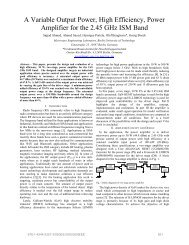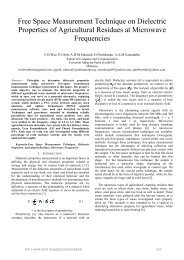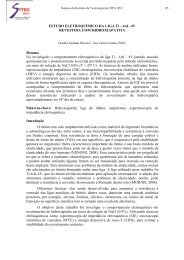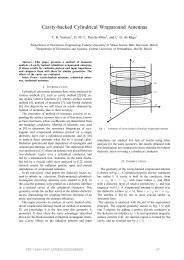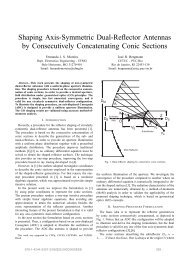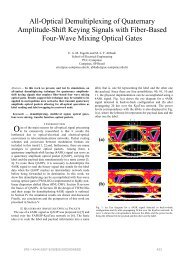Response to Pressure of a Hollow Core Photonic Crystal Fiber for ...
Response to Pressure of a Hollow Core Photonic Crystal Fiber for ...
Response to Pressure of a Hollow Core Photonic Crystal Fiber for ...
Create successful ePaper yourself
Turn your PDF publications into a flip-book with our unique Google optimized e-Paper software.
<strong>Response</strong> <strong>to</strong> <strong>Pressure</strong> <strong>of</strong> a <strong>Hollow</strong> <strong>Core</strong> Pho<strong>to</strong>nic<strong>Crystal</strong> <strong>Fiber</strong> <strong>for</strong> Sensing ApplicationsRafael E. P. de Oliveira and Christiano J. S. de Ma<strong>to</strong>sGrupo de FotônicaUniversidade Presbiteriana MackenzieSão Paulo, Brazilalfaer@gmail.com; cjsdema<strong>to</strong>s@mackenzie.brAbstract — The response <strong>to</strong> pressure <strong>of</strong> a hollow core pho<strong>to</strong>niccrystal fiber is investigated. The fiber is designed <strong>to</strong> operate at1550nm but presents core-guided transmission windows in thevisible spectral range that have shown <strong>to</strong> be highly dependent onthe exact fiber structure. As the fiber is submitted <strong>to</strong> pressure,small structural and index changes, thus, affect these windows.The fiber response depends on whether pressure is appliedinternally or externally and pressure sensitivity can be <strong>of</strong> units <strong>of</strong>kgf/cm² up <strong>to</strong> hundreds <strong>of</strong> kgf/cm². In addition, it was found thatthe fiber presents a birefringence which is also pressuredependent. These characteristics can be exploited <strong>for</strong> thedevelopment <strong>of</strong> pressure sensors based on intensity orpolarization modulation.Keywords - <strong>Hollow</strong> <strong>Core</strong> Pho<strong>to</strong>nic <strong>Crystal</strong> <strong>Fiber</strong>, Pho<strong>to</strong>nicBandgap, <strong>Pressure</strong> SensingI. INTRODUCTIONThe pho<strong>to</strong>nic crystal fibers (PCF) [1] have been largelystudied over the last few years and present several uniquecharacteristics that have been exploited <strong>for</strong> sensing applications[2]-[4]. The freedom <strong>of</strong> design <strong>of</strong> these fibers can lead <strong>to</strong> thedevelopment <strong>of</strong> pressure sensors with better per<strong>for</strong>mance thanthose based on conventional fibers and on fiber Bragg gratings.<strong>Pressure</strong> sensing based on conventional fibers usuallyrequires some mechanical apparatus <strong>to</strong> transduce pressure in<strong>to</strong>an optical measurand. This can be done by measuring theamount <strong>of</strong> light coupled through two butt-coupled fibers asfunction <strong>of</strong> their pressure-induced displacement [5], or bytranslating pressure in<strong>to</strong> strain in a diaphragm on which aBragg grating is attached. This kind <strong>of</strong> configuration canpresent sensitivities <strong>of</strong> the order <strong>of</strong> 2.7 nm.cm²/kgf [6]. Freestandingfiber Bragg gratings directly exposed <strong>to</strong> hydrostaticpressure, on the other hand, show a sensitivity <strong>of</strong> ~2.910 -4nm.cm²/kgf [7]. However, the main shortcome <strong>of</strong> Bragggratings and almost all other types <strong>of</strong> conventional fiber basedsensors is the cross sensitivity with temperature, which needs<strong>to</strong> be compensated <strong>for</strong> [6].Solid-core pho<strong>to</strong>nic crystal fibers with high geometricalbirefringence have been proposed and demonstrated <strong>for</strong>pressure sensing applications, with the measurand beingtransduced in<strong>to</strong> polarization changes and show a pressuresensitivity <strong>of</strong> ~1rad/(kgf/cm².m) [8,9]. As temperature inducesnegligible stress in the air-silica structure, the temperaturesensitivity is as small as 10 -3 rad/(ºC.m) [9]. This virtualinsensitiveness <strong>to</strong> temperature is one <strong>of</strong> the most remarkableadvantages <strong>of</strong> these PCF based sensors.In this paper we study pressure effects on the transmissionand polarization response <strong>of</strong> a hollow core pho<strong>to</strong>nic crystalfiber (HC-PCF) and show its large potential <strong>for</strong> simple, selfreferencedpressure sensing.First we review recent results on the detection <strong>of</strong> unusualtransmission windows in the visible range in an HC-PCFdesigned <strong>to</strong> operate around 1550nm and their pressuredependent power transmission [10]. It is shown that the HC-PCF can work at different pressure ranges (units or hundreds <strong>of</strong>kgf/cm²) depending on how the pressure is applied <strong>to</strong> the fiber.Even though this fiber is not designed <strong>to</strong> be birefringent, itwas found that some birefringence is present due <strong>to</strong> undesirablecore asymmetries and that the birefringence is also sensitive <strong>to</strong>pressure. We then characterize the pressure dependence <strong>of</strong> thepolarization states <strong>of</strong> light guided in one <strong>of</strong> these windows.The observed characteristic responses can be exploited <strong>for</strong>pressure sensing with intensity and/or polarizationtransduction.II. TRANSMISSION CHARACTERIZATION AND INTENSITYRESPONSE TO PRESSUREThe fiber used in the experiments was the hollow corepho<strong>to</strong>nic crystal fiber model HC1550-02 from <strong>Crystal</strong> <strong>Fiber</strong>A/S .Although this model is designed <strong>to</strong> guide around1550nm, high loss core-guided transmission was alsoobserved in the visible spectral range [10]. Those windowscan be observed in short-length fibers (up <strong>to</strong> ~40cm) andpresent estimated attenuation <strong>of</strong> the order <strong>of</strong> 0.8 <strong>to</strong> 1.4 dB/cm.The transmission spectrum in the visible range is highlydependent on the exact structure <strong>of</strong> the fiber and vary fromone sample <strong>to</strong> the other <strong>of</strong> the same fiber model but fromdifferent pre<strong>for</strong>ms. Figure 1 shows the normalizedtransmission spectrum <strong>of</strong> two fiber samples, which are978-1-4244-5357-3/09/$26.00©2009IEEE 299
It was found that new principal axes could be identifiedwhen pressure was applied. Taking axis 1 at atmosphericpressure (figs. 5 and 6) as a reference angle (0°), the new axis1, as a function <strong>of</strong> applied pressure, was found by rotating thepolarizers and measuring the output polarization ellipticities.The new angles are shown in table I <strong>for</strong> two differentpressures. Is can be seen that the principal axis steadily rotateswith pressure, which may indicate that the pressure-inducedstress and de<strong>for</strong>mation does not follow the geometricalsymmetry that yields the birefringence obtained atatmospheric pressure. This feature is not surprising, as theoriginal birefringence is a consequence <strong>of</strong> residual coreellipticity, while stress and de<strong>for</strong>mation may strongly dependon non-uni<strong>for</strong>mities in the fine web structure <strong>of</strong> themicrostructured cladding.TABLE I. ROTATION OF THE PRINCIPAL AXIS WITH PRESSURE.<strong>Pressure</strong> [kgf/cm²]Angular position <strong>of</strong>Axis 10 0°2 10°5 18°Note that the decrease in attenuation observed in figures 6and 7 along the axis that is orthogonal <strong>to</strong> the input polarizationcan be, at least partially, explained via the angular changeswith pressure <strong>of</strong> the principal axes. As these axes rotate thelaunched polarization used <strong>to</strong> plot the figures is no longeraligned with one <strong>of</strong> them and, thus, rotate along the fiber. Thepower along the orthogonal axis is then expected <strong>to</strong> increase,as indeed observed. The increase in attenuation observedalong the input polarization, on the other hand, is believed <strong>to</strong>be connected <strong>to</strong> pressure-induced de<strong>for</strong>mations in the claddingmicrostructure that decreases the bandgap confinement.The observed dynamics may also be somewhat connected<strong>to</strong> different core-mode anticrossings with surface modes thatcan occur at different wavelengths <strong>for</strong> different polarizations[11]. These anti-crossings can yield polarization-dependentlosses that may have <strong>to</strong> be taken in<strong>to</strong> account. Thesepossibilities are currently being investigated.It can be seen that pressure significantly affects thepolarization dynamics in the studied hollow core fibers, whichcan be exploited <strong>for</strong> sensing applications. Note, in particular,that, unlike pressure, temperature is expected <strong>to</strong> isotropicallyaffect the microstructured cladding and is, thus, not expected<strong>to</strong> induce a principal axis rotation. This feature may beexploited in the design <strong>of</strong> temperature independent sensorsthat operate beyond the 100 o C limit observed <strong>for</strong> themeasurements reported in section II.CONCLUSIONSThe response <strong>to</strong> pressure <strong>of</strong> identified transmissionwindows in the visible spectral range in a HC-PCF wasstudied. It was shown that measurable intensity responses <strong>for</strong>pressures <strong>of</strong> hundreds or units <strong>of</strong> kgf/cm² ocurr dependingwhether pressure is applied externally or internally. Forinternal pressure the guided-mode polarization dynamics, aswell as the fiber birefringence, were also characterized. Theresults indicate that along with attenuation changes, pressurealso shifts the principal axes <strong>of</strong> the fiber, inducing couplingbetween orthogonal polarizations.The presented features can be exploited in the developmen<strong>to</strong>f pressure sensors based on hollow core pho<strong>to</strong>nic crystalfibers in which the measurand is transduced in<strong>to</strong> eitherpolarization or intensity. The sensors can be self referenced, iftwo or more transmission windows, or else a single windowand the two orthogonal polarizations, are simultaneouslymoni<strong>to</strong>red. The results presented can also help <strong>to</strong> improve thefabrication <strong>of</strong> optimized hollow-core fibers <strong>for</strong> pressuresensing applications.ACKNOWLEDGMENTThe authors acknowledge the contributions <strong>of</strong> Dr. CristianoM. B. Cordeiro and Juliano G. Hayashi in the intensityresponse measurements and <strong>of</strong> Dr. Marcos A. R. Franco in thecalculation <strong>of</strong> the fiber birefringence. This work is supportedby CNPq, FAPESP, CAPES and Mackpesquisa.REFERENCES[1] P. Russel, “Pho<strong>to</strong>nic <strong>Crystal</strong> <strong>Fiber</strong>: Finding the Holey Grail,” Optics andPho<strong>to</strong>nics News, vol. 18, pp. 26-31, July/August 2007.[2] T. T. Alkeskjold, J. Lægsgaard, A. Bjarklev, D. S. Hermann, J. Broeng,J. Li, S. Gauza, and S.-T. Wu, Appl. Opt., vol. 45, pp. 2261-2264, April2006.[3] C. M. B. Cordeiro, C. J. S. de Ma<strong>to</strong>s, E. M. dos San<strong>to</strong>s, A. Bozolan, J. S.K. Ong, T. Facincani, G. Chesini, A. R. Vaz, and C. H. Bri<strong>to</strong> Cruz,Meas. Sci. Technol., vol. 18, pp. 3075-3081, September 2007.[4] J. B. Jensen, L. H. Pedersen, P. E. Hoiby, L. B. Nielsen, T. P. Hansen, J.R. Folkenberg, J. Riishede, D. Noordegraaf, K. Nielsen, A. Carlsen, andA. Bjarklev, Opt. Lett., vol. 29, pp. 1974-1976, September 2004.[5] D. A. Krohn, <strong>Pressure</strong> Sensors, in <strong>Fiber</strong> Optic Sensors, ResearchTriangle Park: Instrument Society <strong>of</strong> America, 2000, pp 143-151.[6] Y. S. Hsu; Likarn Wang; Wen-Fung Liu; Y. J. Chiang, IEEE Pho<strong>to</strong>n.Technol. Lett., vol. 18, pp. 874-876, April 2006.[7] M. G. Xu, L. Reekie, Y. T. Chow, and J. P. Dakin, Electron. Lett., vol.29, pp. 398-399, February 1993.[8] T. Nasilowski et al., Appl. Phys. B, vol. 81, pp. 325-331, July 2005.[9] W. J. Bock, J. Chen, T. Eftimov, and W. Urbanczyk, IEEE T. Instrum.Meas., vol. 55, pp. 1119-1123, August 2006.[10] R. E. P. de Oliveira; C. J. S. de Ma<strong>to</strong>s; J. G. Hayashi and C. M. B.Cordeiro, “<strong>Pressure</strong> Sensing Based on Nonconventional Air-GuidingTransmission Windows in <strong>Hollow</strong>-<strong>Core</strong> Pho<strong>to</strong>nic <strong>Crystal</strong> <strong>Fiber</strong>s,” J.Lightwave Technol., vol. 27, no. 11, pp. 1605-1609, June 2009.[11] F. Poletti, N. G. R. Broderick, and D. J. Richardson, “The effect <strong>of</strong> coreasymmetries on the polarization properties <strong>of</strong> hollow core pho<strong>to</strong>nicbandgap fibers,” Opt. Express, vol. 13, pp .9115-9124, Oc<strong>to</strong>ber 2005.2009 SBMO/IEEE MTT-S International Microwave & Op<strong>to</strong>electronics Conference (IMOC 2009) 302



